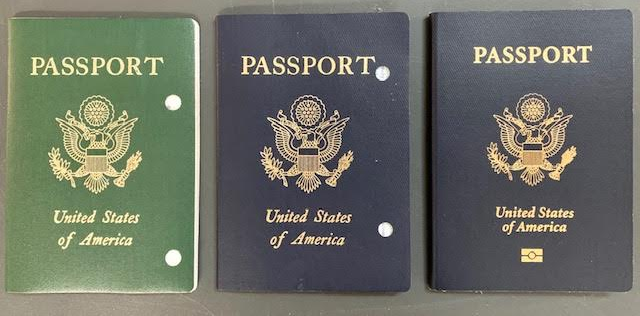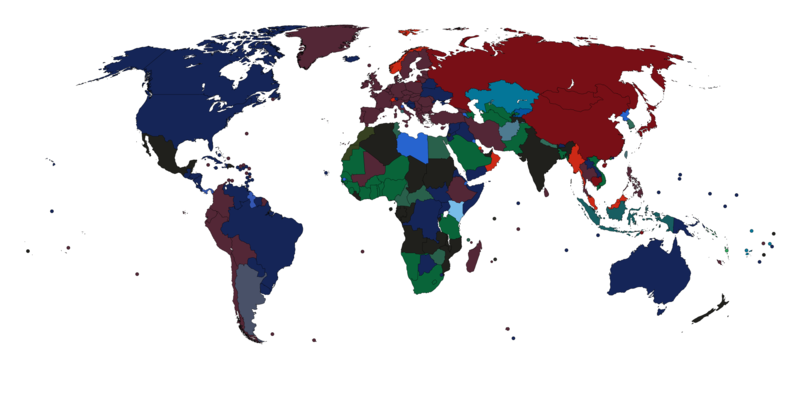If you have a passport and are from the United States, chances are your passport is blue. If you’re from Germany, your passport is probably burgundy. If you’re Egyptian, I bet your passport is green.
I always wondered why different countries had different colored passports. Was there a certain significance to the color? Did it ever change, etc? It turns out there are indeed reasons for all of that and more.
A History of U.S. Passport Colors
I’m from the U.S., so I’ll start there.
Most U.S. passports are currently blue but that wasn’t always the case. The first passports issued by the U.S. State Department, from 1780-1917, were just pieces of paper. Granted, they were “official” pieces of paper, but still… (before World War I the passport was typically a large [11 x 17 in] piece of paper, with a large engraved seal of the Department of State at the top, repeated in red wax at the bottom, the bearer’s description and signature on the left, and his name on the right above space for data such as “accompanied by his wife,” all in ornate script), but still… After WWI ended in 1918, the passport documents were made smaller and were folded and glued to a protective brown cloth. In 1921, they put a hard green cover on top of the green cloth so the passport would have more protection. In 1926, they changed their color again; from 1926 to 1941, they were red. From 1941 to 1976, they were green. They became even smaller in the 1970s. They switched color to blue in 1975 for the bicentennial and kept it that color. Except for one year, from April 1993 to March 1994, they made them green again to honor Benjamin Franklin and the 200th anniversary of the US Consular Service. As it turned out, my first passport was issued in January 1994, and it’s green.

My passports, issued in 1994, 2004 and 2014
Currently, blue passports are for regular U.S. citizens, but the United States also issues passports of different colors. Brown passports are for U.S. government employees, contractors and military personnel. They’re only supposed to use the brown passports for ‘official’ work, so they also carry regular blue ones for personal travel. Diplomats are issued black passports. Refugee Travel Documents are light green. They look like passports but don’t indicate U.S. citizenship. They’re given to refugees living in the United States when they can’t get a passport from their country of origin.
Passport Colors Around the World
There are generally four colors of passports – black, blue, green and red, although different shades of each color are used.

- Many countries in Europe use varying shades of red/burgundy. There are some in South America (i.e., Bolivia, Colombia, Ecuador, and Peru) that choose red to signify they’re part of the Andean Community of Nations. Countries that have a history of Communism also tend to choose shades of red for their passports. Singapore uses a red passport to mirror the country’s flag.
- Blue passports are traditionally associated with “New World” nations (think United States, Canada and Australia), but most Caribbean countries use dark blue for their covers to demonstrate their membership in the “Caribbean Community.” Some South American countries, including Brazil, Argentina, and Paraguay, also use blue for their connection with the trade union Mercosur. The U.K.’s passport had been blue in the distant past, and changed, more recently, to red, but with Brexit, they’re switching back to blue (since the death of Queen Elizabeth, the passports of people from the UK and Commonwealth countries have also had a change from all mentions of Her Majesty to His Majesty King Charles III. However, those changes only occur when individuals’ respective passports expire and need to be renewed – or if they’re getting their first passport).
- Most Islamic countries (i.e., Egypt, Morocco, Pakistan and Saudi Arabia) have green passports because green is an important color in the Muslim religion. A handful of West African countries (think Burkina Faso, the Ivory Coast, Niger, Nigeria and Senegal) also have green passports to represent they belong to ECOWAS (the Economic Community of West African States). However, Taiwan (a.k.a. Republic of China) also uses a green passport. During their most recent passport design change, in 2020, they still kept the dark green cover.
- You can find black passports in possession of citizens from several African countries such as Angola, Botswana, Burundi, Chad, Congo, Malawi, Zambia, etc. New Zealand also uses black passport covers because black is the country’s national color.
- India is the one outlier – they began offering their residents passports with orange jackets in 2018.
And now you know 😉
Want to comment on this post? Great! Read this first to help ensure it gets approved.
Want to sponsor a post, write something for Your Mileage May Vary, or put ads on our site? Click here for more info.
Like this post? Please share it! We have plenty more just like it and would love it if you decided to hang around and sign up to get emailed notifications of when we post.
Whether you’ve read our articles before or this is the first time you’re stopping by, we’re really glad you’re here and hope you come back to visit again!
This post first appeared on Your Mileage May Vary

11 comments
There is no law or treaty to assign passport colors. Any country can choose whatever color they want. True, one can detect some patterns but it is merely a reflection of what countries choose.
I’m sorry…did I say somewhere that passport colors were because of certain laws or treaties?
“because green is an important color in the Muslim religion”
Tell me you don’t know why it’s important without telling me you don’t know why it’s important
Actually, I do know (supposed to have been Mohammed’s favorite color and/or it being a color of nature, are a start). It just wasn’t important for this post.
You know what happens when one assumes, yes?
I had a green one way back…
Interesting to hear about India’s orange passport. Turns out they have four passport colors: https://timesofindia.indiatimes.com/travel/destinations/what-does-dark-blue-maroon-white-and-orange-colours-in-indian-passport-represent/articleshow/113874661.cms
I have a significant suggestion:
Assigning Blue Passports to US Blue States citizens
And Red Passports to US Red Blue States ones.
Thus, we can choose in Europe/The Real democratic world who we want to welcome and how.
I’m not sure how you think “blue” or “red” states have anything to do with passport cover colors? Passports signify countries, not states.
It was definitely ironic about Republican States and Blue ones in the current geopolitical context.
In other words, Trumps voters, we don’t want you in our Democratic countries.
Buuuuuuut it still has nothing to do with passport cover colors.
Least having a red Japanese passport and a blue US passport means no mixup at immigrations.